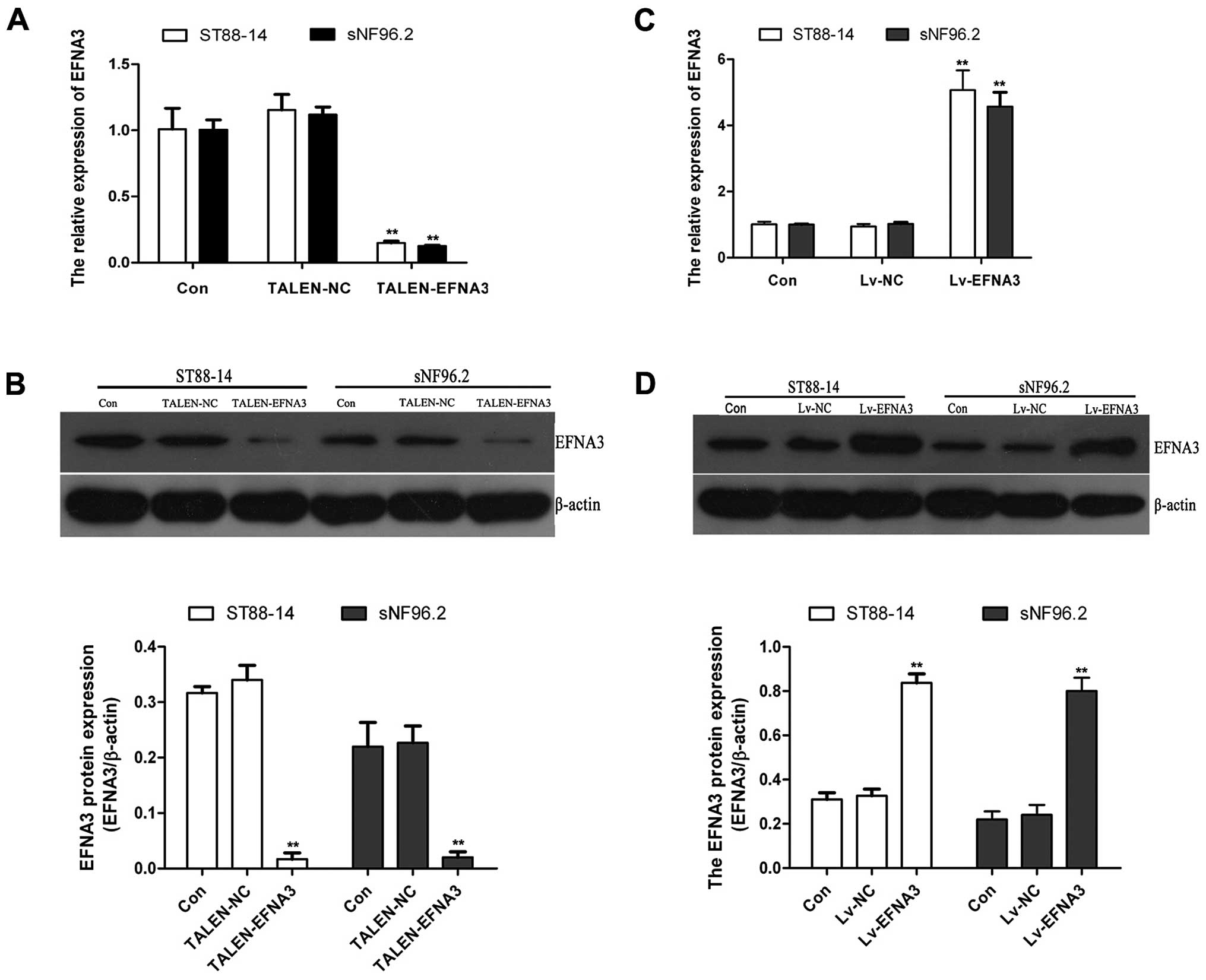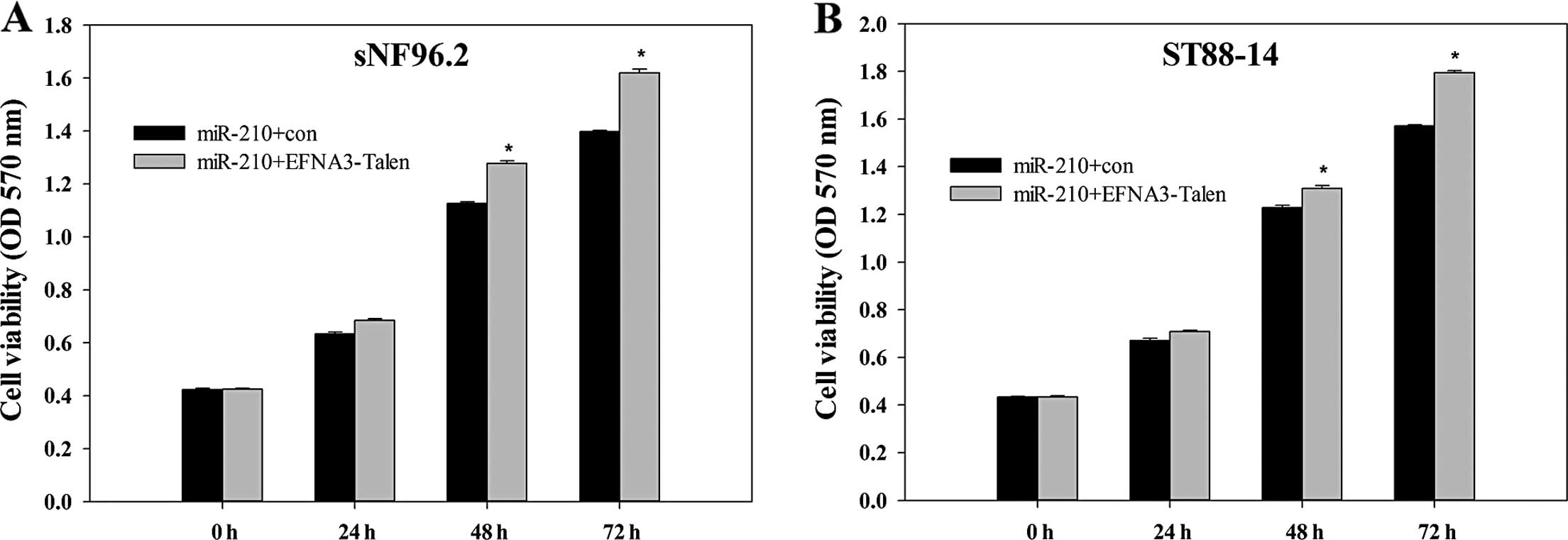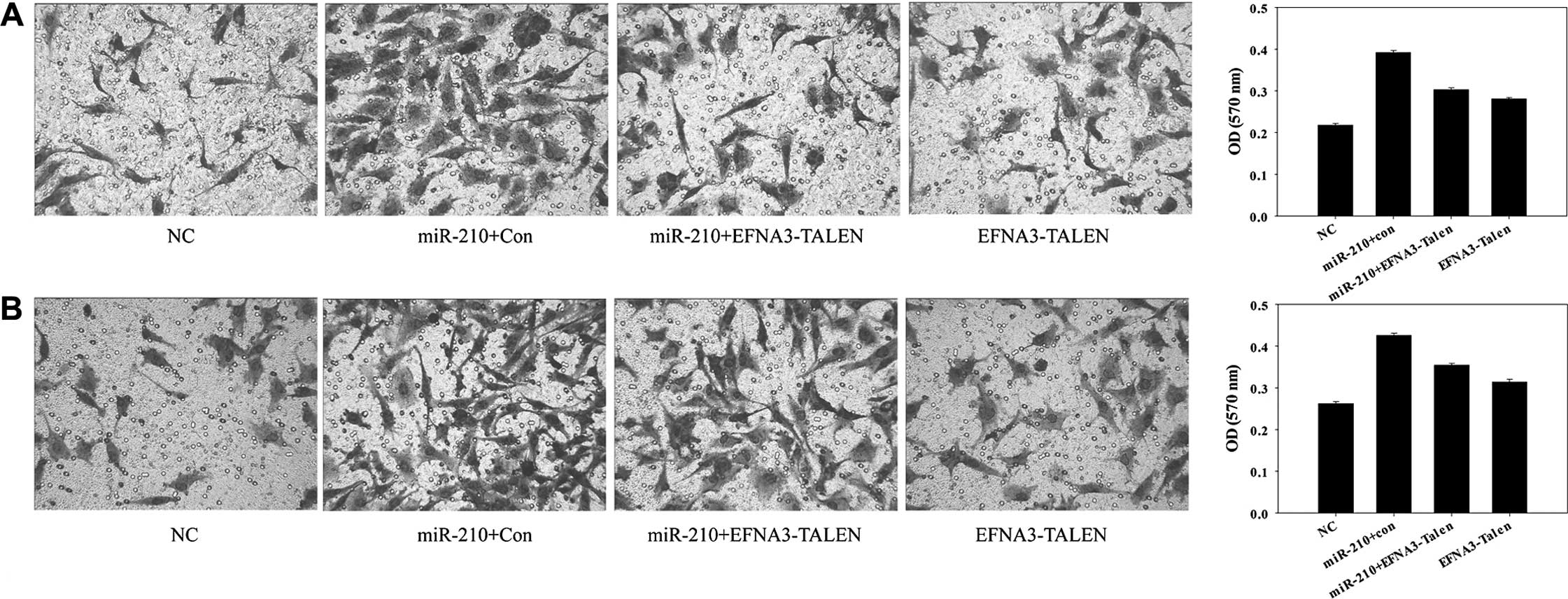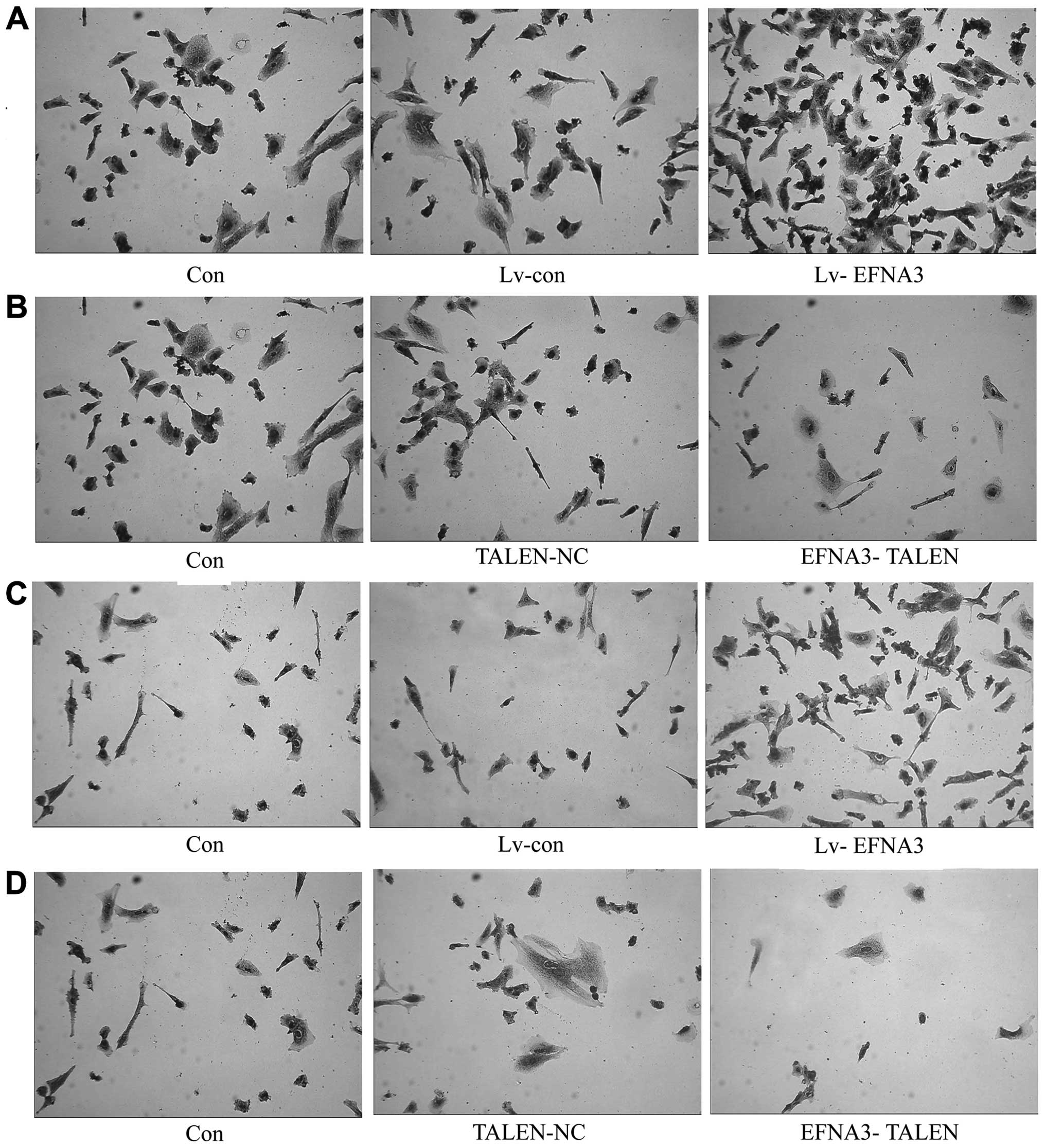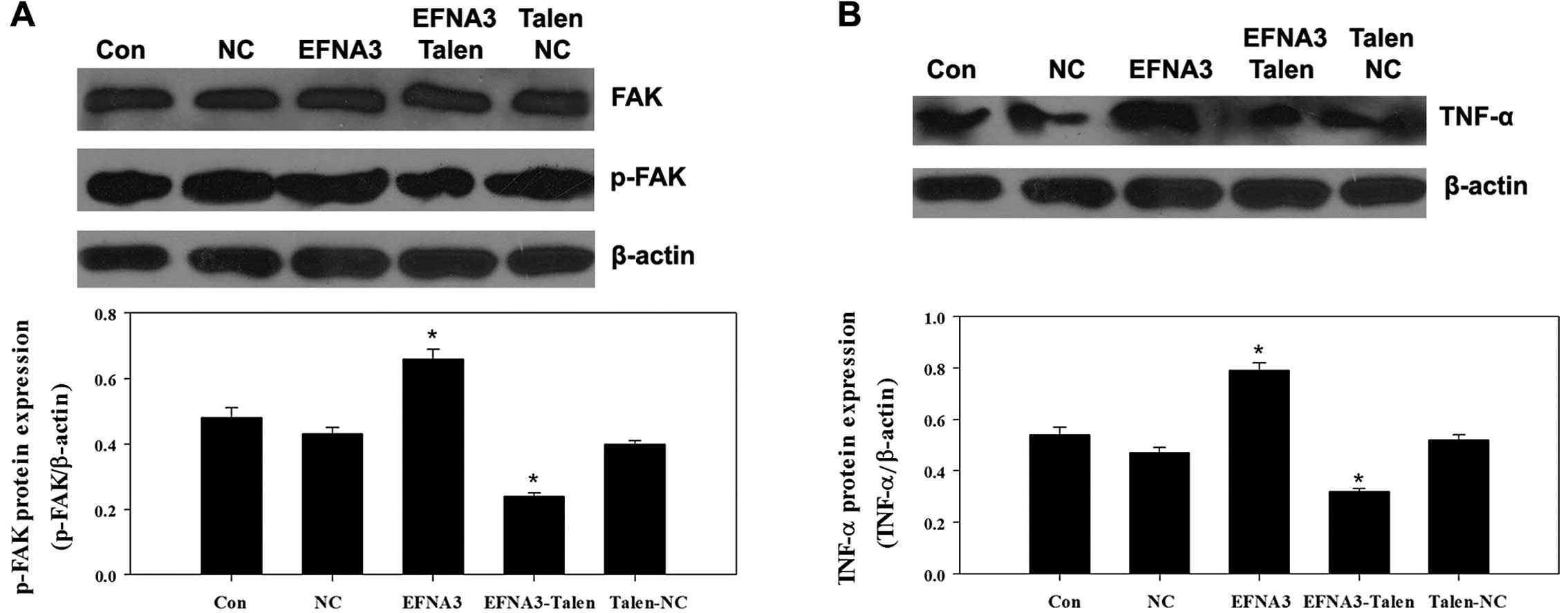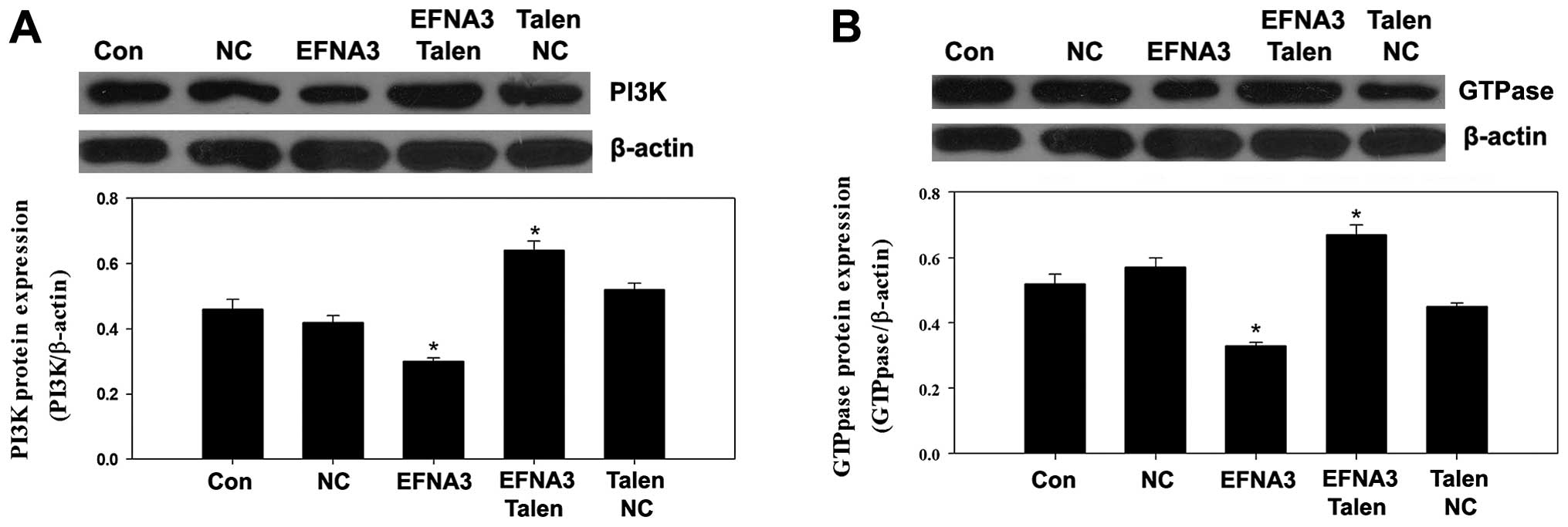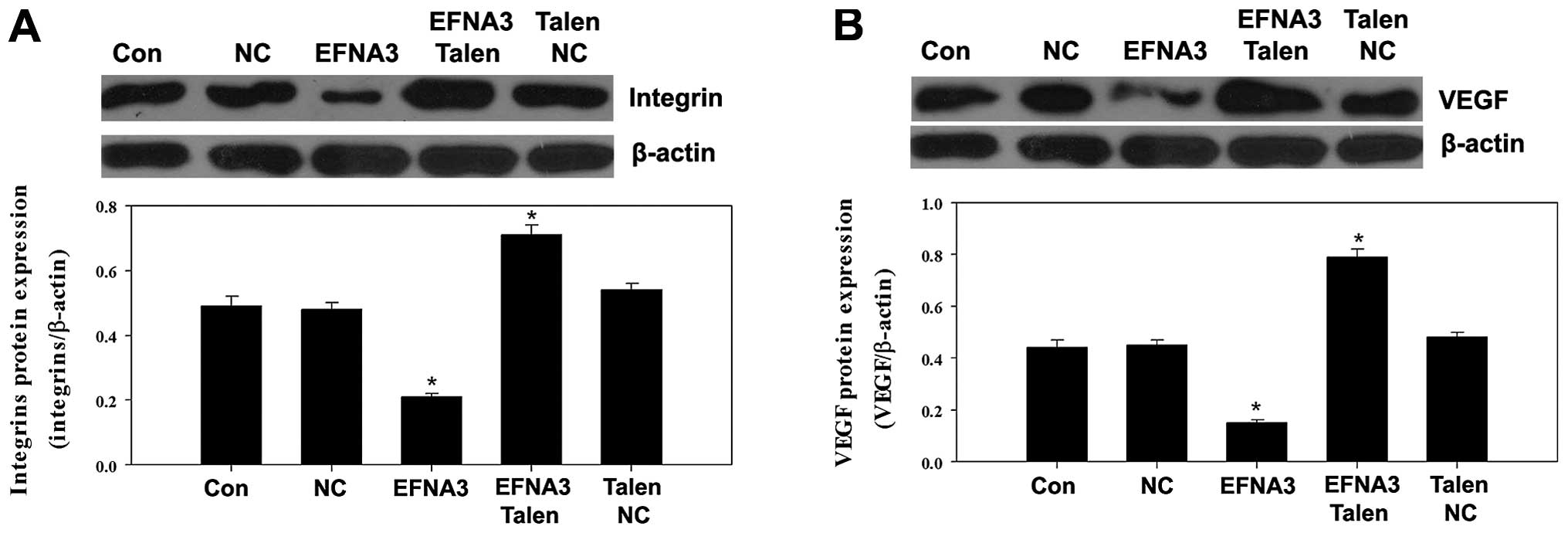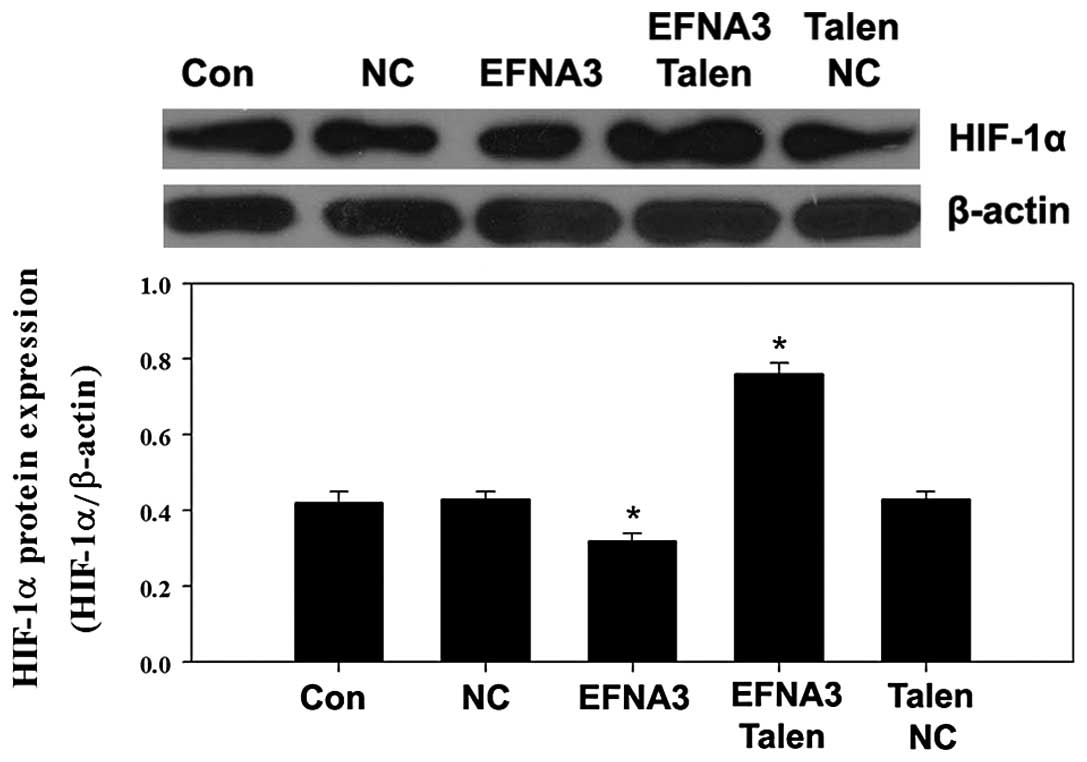Dissecting the roles of Ephrin-A3 in malignant peripheral nerve sheath tumor by TALENs
- Authors:
- Published online on: May 8, 2015 https://doi.org/10.3892/or.2015.3966
- Pages: 391-398
Abstract
Introduction
Malignant peripheral nerve sheath tumor (MPNST), typically arising from Schwann cells of peripheral nerve sheaths (1–3), is known as the most aggressive peripheral nerve malignant tumors. MPNST is the main soft tissue malignancy associated with neurofibromatosis type 1 (NF1) (4). It has been reported that ~80% of MPNSTs are pathologically indicated as high-grade tumors (2). Furthermore, studies have shown that 20–50% of patients with MPNST also have NF1 and ~10% of patients with NF1 will finally suffer from MPNST (1,4,5). Traditional treatment methods including surgical resection, chemotherapy and radiotherapy can not obtain an ideal curative effect mainly due to the aggressive growth and metastasis of MPNST. Therefore, it is urgent to clarify the underlying molecular mechanism of MPNST for developing new molecular therapeutic tools.
Eph receptors represent the largest family of receptor tyrosine kinases (RTKs), which are capable of recognizing signals from the cell environment and influencing cell-cell interaction and cell migration (6–8). Ephrins are the ligands to Eph receptors and they stimulate bi-directional signaling of the Eph-ephrin axis. Ephrin-A3 (EFNA3) is one of the ephrin ligands which could bind to EphA2, EphA3, EphA5, EphA7, EphA8 and more poorly to EphA4. It is not only expressed in skeletal muscle, spleen, thymus, prostate, testis, ovary, small intestine and peripheral blood leukocytes, but is also present in neuroblastomas, neural cancers and leukemias. The dysregulated expression of EFNA3 has been observed in many types of human cancer. The expression level of EFNA3 was found to be upregulated 26-fold in squamous cell lung carcinoma, 3.8-fold in liver cancer, 1.6-fold in colon cancer and downregulated 2.6-fold in kidney carcinoma (9–12). Our previous study also showed that mRNA expression levels of EFNA3 were significantly decreased in MPNST cell lines (1). However, the molecular mechanism by which EFNA3 mediates MPNST cells is still unknown.
MicroRNAs (miRs), a kind of endogenous non-coding RNAs, can serve as endogenous agents for RNA interference. Growing evidence indicates that miRs deregulation is closely related to certain pathological processes including tumorigenesis. miRs can act as tumor suppressors or oncogenes depending on their targets (13). Among these functional miRs, miR-210 is frequently upregulated in various types of cancer, such as glioblastoma (14), clear cell renal cell carcinoma (15), lung (16) and breast cancer (17,18). miR-210 may play an oncogenic role in cancer initiation and progression via regulating cellular growth, apoptosis, migration and invasion (19,20). In MPNST, Presneau et al identified 16 significantly differentially expressed miRs in MPNST relatively to neurofibromas. Of these, miR-210 was identified with increased expression (21). In addition, our previous study (1) indicated that miR-210 reduced the expression of its target gene EFNA3 and stimulated growth and invasion of MPNST. Accordingly, EFNA3 plays a role in MPNST progression and miR-210 acts as an oncogene. However, the relationship between miR-210 and EFNA3 in MPNST cells requires further investigation.
Overexpression and knockout of a specific gene are the crucial strategies for gene function study. Transfection strategies, which along with plasmid or lentiviral vectors, are known as the powerful methods for overexpression of a specific gene. Various technical tools have been developed to probe the functions of genes, yet their application has been limited by low efficacy and specificity (22). Recently, transcription activator-like effector nucleases (TALENs) emerged as a novel promising tool for gene function analysis. TALENs are artificial restriction enzymes generated by fusing a TAL effector DNA binding domain to a DNA cleavage domain. Transcription activator-like effectors (TALEs) can be quickly engineered to bind practically any desired DNA sequence (23). When these restriction enzymes are introduced into cells, they can be used for gene knockout. In the present study, TALENs and lentiviral transfection strategies were applied to dissect the roles of EFNA3 in MPNST cells and to reveal correlation between EFNA3 and miR-210. The present study may facilitate better understanding of MPNST pathogenesis and the development of potential therapeutic targets for MPNST.
Materials and methods
Cell culture
MPNST ST88-14 (NF1 wild-type) and sNF96.2 (NF1 mutant type) cell lines were purchased from the China Center for Type Culture Collection (CCTCC; Wuhan, China). All the cells were cultured in Dulbecco’s modified Eagle’s medium (DMEM) supplemented with 10% fetal bovine serum (FBS; Life Technologies, Carlsbad, CA, USA), 100 IU/ml penicillin and 100 µg/ml streptomycin sulfate at 37°C in a humidified incubator containing 5% CO2.
Antibodies
Antibodies of EFNA3 and β-actin were obtained from Santa Cruz Biotechnology (Dallas, TX, USA). Antibodies of focal adhesion kinase (FAK), phosphorylation FAK (p-FAK), PI3K, integrins, TNF-α and HIF-1α were purchased from ImmunoWay Biotechnology (Newark, DE, USA). Antibodies of GTPase and VEGF were purchased from Abzoom (Dallas, TX, USA).
Real-time RT-PCR
Total RNA was extracted from cells (MPNST cell line ST88-14, T265p21, sNF96.2, YST-1 and MPNST-14 cells were purchased from CCTCC or Schwann cells separated from human NF1 neurofibroma tissues) with TRIzol reagent (Life Technologies) following the manufacturer’s instructions. The expression of EFNA3 mRNA was detected by real-time RT-PCR using the standard SYBR-Green RT-PCR kit (Takara, Otsu, Japan) following the manufacturer’s instructions. The specific primer pairs are as follows: EFNA3 sense, 5′-CTTGTGGCTCTGGTAATGTTTGG-3′ and anti-sense, 5′-GAGGAGGACGTGCTTATTGCTGT-3′; β-actin as an internal sense, 5′-AGGGGCCGGACTCGTCATACT-3′ and antisense, 5′-GGCGGCACCACCATGTACCCT-3′. The relative expression of the gene mRNA was quantified using the GraphPad Prism 4.0 software (GraphPad Software, San Diego, CA, USA) and the 2−ΔΔCt method (24).
Design and construction of TALENs
TAL effector DNA binding domains were designed and constructed based on TAL Effector Nucleotide Targeter 2.0 (25). The sites: gggaaaccggcatgcggt (left) and ccccgactcactgctggt (right) were chosen. According to Sanjana et al (26), the binding pairs EFNA3-L and EFNA3-R were, respectively, assembled into the pTALEN-v2-L and pTALEN-v2-R backbones, yielding pTALEN-EFNA3-L and pTALEN-EFNA3-R.ST88-14 and sNF96.2 cells were transfected with a mixture of pTALEN-EFNA3-L, pTALEN-EFNA3-R (untreated cells were used as a control). Cells were trypsinized and resuspended after transfection for 4 days. The transfected cells were expanded. To confirm the disruption of EFNA3, western blotting and PCR were performed. Whole cell extracts were analyzed by western blotting, and the targeted exon was PCR-amplified from genomic DNA isolated from individual clones. The following day, the medium was refreshed and grown for an additional 24 h prior to harvesting for further analysis.
Lentiviral transfection
The Lv-EFNA3 and Lv-NC lentiviral suspension was purchased from GeneChem (Shanghai, China). The titer of the lentiviral vectors was 2×1010 titer units (TU)/ml. The ST88-14 and sNF96.2 cells were plated and cultured in 6-well plates until cell fusion reached 60–70%. Then, 2.5×104 TU/well Lv-EFNA3 or Lv-NC lentivirus was added to the cells under MOI values of 50. To confirm the effect of the lentivirus on the expression of EFNA3 gene, PCR and western blotting was performed to determinate the mRNA and protein levels of EFNA3 in the ST88-14 and sNF96.2 cells after infection with lentivirus for 6 days. The transfected cells were expanded and harvested for further analysis.
Cell viability assay
MPNST ST88-14 and sNF96.2 cells transfected with pTALEN-EFNA3-L, pTALEN-EFNA3-R and pre-miR-210 or pre-miR-210 in exponential growth were plated at a final concentration of 2×103 cells/well in 96-well plates. The viability of the cells was evaluated by an MTT assay after 24, 48, 72 and 96 h of seeding. The optical density at 570 nm (OD570) of each well was measured with an ELISA reader (ELX-800 type; BioTek, Winooski, VT, USA).
Cell invasion assay
The cell invasion assay was performed using a Cell Invasion Assay kit (Chemicon International, Temecula, CA, USA) according to the manufacturer’s guidelines. Briefly, ST88-14 and sNF96.2 cells transfected with pTALEN-EFNA3-L and pTALEN-EFNA3-R or pre-miR-210 or pTALEN-EFNA3-L, pTALEN-EFNA3-R and pre-miR-210 and their corresponding negative control was placed in the upper compartment of the chambers, and DMEM containing 10% FBS was added in the lower chambers. After 24 h of incubation at 37°C, cells on the upper face of the membrane were scraped using a cotton swab and cells on the lower face were fixed, stained and observed under a microscope. Then the dye on the membrane was dissolved with 10% acetic acid, dispensed into 96-well plates (150 µl/well), and the optical density at 570 nm (OD570) of each well was measured with an ELISA reader (ELX-800 type).
Cell adhesion assay
Adhesion was assayed by plating cells in DMEM on 96-well plates pre-coated with bovine serum albumin (BSA) as a control or 20 µg/ml fibronectin (FN) (both from Life Technologies), respectively. Cells were pre-treated overnight with MPNST cells and were allowed to adhere for 2 h. Wells were washed, fixed with 4% paraformaldehyde and stained with crystal violet (Life Technologies). Adhered cells were counted under a microscope (AE31 type; Motic, HK, China) in five fields.
Western blotting
Cells were lysed in cell lysate, and then centrifuged at 12,000 × g for 20 min at 4°C. The supernatant was collected and denatured. Proteins were separated in 10% SDS-PAGE and blotted onto polyvinylidene difluoride membrane (PVDF). The PVDF membrane was treated with TBST containing 50 g/l skimmed milk at room temperature for 4 h, followed by incubation with the primary antibodies of EFNA3, FAK, p-FAK, PI3K, GTPase, integrins, VEGF, TNF-α, HIF-1α and β-actin, respectively, at 37°C for 1 h. Membranes were rinsed and incubated for 1 h with the correspondent peroxidase-conjugated secondary antibodies. Chemiluminent detection was performed with the ECL kit (Pierce Chemical Co., Rockford, IL, USA).
Statistical analysis
Data are expressed as mean ± SD from at least three separate experiments. Statistical analysis was carried out using SPSS 15.0 software. The difference between the two groups was analyzed by the Student’s t-test. A value of P<0.05 was considered to indicate a statistically significant result.
Results
Knocked out or overexpressed EFNA3 in ST88-14 and sNF96.2 cells
In the present study, ST88-14 and sNF96.2 cells were selected to investigate the functions of EFNA3 in MPNST. TALENs are emerging as a new powerful technique in the field of targeted genome engineering. TALENs were applied for knockout of EFNA3 gene in MPNST cells. After transfection with pTALEN-EFNA3-L and pTALEN-EFNA3-R, the expression levels of EFNA3 mRNA and protein in ST88-14 and sNF96.2 cells were analyzed by RT-PCR and western blotting. The expression of EFNA3 mRNA and protein were detected (Fig. 1A and B). These results suggested that EFNA3 gene was effectively knocked out by EFNA3-TALENs in ST88-14 and sNF96.2 cells.
EFNA3 was also overexpressed by lentiviral transfection. After transfection with lentiviral recombinant vectors, RT-PCR and western blotting were performed to analyze the expression of EFNA3 mRNA and protein. As shown in Fig. 1C and D, the expression of EFNA3 mRNA and protein increased significantly in transfected LV-EFNA3 cells compared with transfected LV-NC vector and control cells. The above indicated that EFNA3 gene was overexpressed effectively by the LV-EFNA3 transfected in ST88-14 and sNF96.2 cells.
Effect of EFNA3 on the viability of MPNST cells
MTT assay, generally applied to detect the viability of the cellse, was employed to investigate the effect of EFNA3 on the viability of ST88-14 and sNF96.2 cells. MPNST cells, with the EFNA3 gene present or knocked out, was transfected with pre-miR-210. Subsequently, the cell viabilities were evaluated every 24 h for 3 days. As shown in Fig. 2A and B, although the MPNST cells were all transfected with pre-miR-210, the viabilities still increased in ST88-14 and sNF96.2 cells when EFNA3 was knocked out. This suggested that the knockout of EFNA3 promoted the viability of the MPNST cells.
Effect of EFNA3 on invasiveness of MPNST cells
The rising invasiveness is an important feature of malignant tumors. The effects of EFNA3 on invasiveness of MPNST ST88-14 and sNF96.2 cells were examined by a Transwell assay. The results showed that knockout of EFNA3 by introduction of pTALEN-EFNA3-L and pTALEN-EFNA3-R, or overexpression of miR-210 by introduction of pre-miR-210, both strongly increased the invasiveness of ST88-14 and sNF96.2 cells (Fig. 3A and B). It was also noted that the overexpression of miR-210 had more power in increasing the invasiveness of the MPNST cells than that of the knockout of EFNA3. In addition, the MPNST cells with both knockout EFNA3 and overexpression of miR-210 increased the invasiveness of the cells as well. As presented in Fig. 3, the enhancement degree of invasiveness in MPNST cells with both the knocked out EFNA3 and overexpressed miR-210 were greater than that of EFNA3 knockout MPNST cells, but weaker than that of miR-210 overexpressed MPNST cells, suggesting that EFNA3 had a negative effect on the invasiveness of the MPNST cells. Furthermore, EFNA3 may not be the only target gene of miR-210.
Effect of EFNA3 on adhesion of MPNST
The adhesion capability of cancer cells is closely related with metastasis. To investigate the effect of EFNA3 on adhesion of MPNST cells, EFNA3 in ST88-14 and sNF96.2 cells was knocked out by TALENs that also overexpressed EFNA3 through Lv-EFNA3 transfection. Our data showed that the adhesion capability of MPNST cells was inhibited after knocking out EFNA3, while overexpression of EFNA3 enhanced the adhesion capability of both ST88-14 and sNF96.2 cells (Fig. 4A–D). These findings suggest that EFNA3 inhibits MPNST metastasis by promoting the adhesion of MPNST cells.
Molecular mechanism underlying the role of EFNA3 in tumor angiogenesis
To explore the potential molecular mechanisms underlying EFNA3-induced tumor angiogenesis, the expression of some protein members of FAK signaling pathway including FAK, p-FAK, phosphatidylinositol 3-kinase (PI3K), GTPase as well as integrins and angiogenic factors including vascular endothelial growth factor (VEGF), tumor necrosis factor α (TNF-α) and hypoxia-inducible factor 1α (HIF-α) were determined by western blotting. We found that knockout of EFNA3 notably decreased the protein expression of p-FAK and TNF-α compared to the control groups (Fig. 5A and B), while the protein expression levels of PI3K, GTPase, integrins, VEGF and HIF-α were significantly increased (Figs. 6Figure 7–8). All these changes were beneficial to the progression of the tumor. On the contrary, overexpression of EFNA3 significantly upregulated the protein expression of p-FAK and TNF-α compared to the control groups (Fig. 5A and B), yet the protein levels of PI3K, GTPase, integrins, VEGF and HIF-α were notably reduced (Figs. 6Figure 7–8). These data indicated that knockout and overexpression of EFNA3 improved and inhibited progression of MPNST cells, respectively. These data suggest that EFNA3 may function as a tumor suppressor in MPNST.
Discussion
Ephrin ligands and their Eph receptors have been proven to play a crucial role in mediating a wide range of biological activities, such as angiogenesis, cell segregation, cell adhesion, shape and motility. As several of these processes are known to go awry during tumorigenesis and metastasis, Eph/ephrin signaling has been identified to play a role in many human cancers, such as lung, breast and prostate cancers, as well as melanoma and leukemia (9). Ephrin-A3 (EFNA3) is a GPI-anchored membrane protein and is widely expressed in human organisms, such as skeletal muscle, spleen, thymus, prostate, testis, and ovary (27). EFNA3 has been proven to play an important role in the guidance of various types of axons in the developing nervous system (28–30) and in the control of dendritic spine morphology (31). EFNA3 has also been proposed to be associated with some cancers. Iiizumi et al found that EFNA3 facilitated the growth of pancreatic cancer cells (32). Georgiou et al indicated that EFNA3 served as an angiogenesis-specific gene and its expression was upregulated in patients with breast cancer (33). Our previous study indicated that EFNA3 may play a part in the process of miR-210 promotion of growth and invasion of MPNST (1). Subsequently, the functions of EFNA3 in MPNST were investigated in this study.
In the present study, we investigated the function of EFNA3 by gain- and loss-of-function strategies. EFNA3-TALENs and Lv-EFNA3 were transfected into MPNST cells to knock out and overexpress EFNA3, respectively. The EFNA3 mRNA and protein levels were determined by RT-PCR and western blotting, and the results indicated that EFNA3 gene in ST88-14 and sNF96.2 cells were effectively knocked out by EFNA3-TALENs suggesting the promising application of TALENs in cancer associated gene function study.
We further investigated the performance of ST88-14 and sNF96.2 cells with EFNA3 present or knockout, on cell viability. The results suggested that knockout of EFNA3 significantly promoted the viability of MPNST cells even when miR-210 was pre-upregulated. Notably, our previous study showed that miR-210 promotes viability and proliferation of MPNST cells through negative regulation of EFNA3 (1). In the present study, although the MPNST cells were all transfected with pre-miR-210, the viabilities still increased in ST88-14 and sNF96.2 cells when EFNA3 was further knocked out, implying that EFNA3 interfered in the viability of MPNST cells more directly than miR-210. Subsequently, the invasiveness of ST88-14 and sNF96.2 cells transfected with EFNA3-TALENs or pre-miR-210 or both recombinant vectors were determined. Although the invasiveness of all transfected MPNST cell lines was increased, the enhancement degree was different in each. The enhancement degree of the invasiveness in the MPNST cells that were transfected with both EFNA3-TALENs and pre-miR-210 was greater than that of EFNA3-TALENs transfected cells but it was weaker than that of pre-miR-210 transfected cells. These data suggest that EFNA3 may not be the only target gene of miR-210. It was also consistent with the findings in our previous study, in which the ZNF462 gene was also indicated as a potential target of miR-210 (1). Besides, Fasanaro et al also identified some other targets of miR-210, including E2F3, MNT, APC, ACVR1B and CDK10, which were also demonstrated to be tumor suppressors (34).
Angiogenesis is always closely associated with tumor growth and metastasis. FAK signaling has been shown to promote angiogenesis in embryonic development as well as various physiological and disease processes in adult organism, including tumor angiogenesis (35). In addition, FAK signaling members and angiogenic factors have been implicated in tumorigenesis with regards to the Eph/ephrin axis. A study by Miao et al showed that EphA2 stimulation with ephrin-A1 leads to the recruitment of the protein tyrosine phosphatase SHP-2 to EphA2, followed by dephosphorylation of FAK and paxillin (36). Brantley et al validated the complementary expression of EphA2 in tumor blood vessel endothelium and ephrin-A1 in tumor cells as the first functional evidence of type-A Eph receptor regulation of pathogenic angiogenesis in tumors (37). Accordingly, the expression level of FAK signaling proteins and angiogenic factors were determined by western blotting to further clarify the potential molecular mechanisms underlying EFNA3-induced tumor angiogenesis in the present study. The results indicated that knockout of EFNA3 significantly decreased the expression of p-FAK. However, the expression of PI3K, GTPase and intergins were increased (Fig. 5). These suggested that FAK signaling was negatively regulated by phosphorylation of FAK. Generally, the FAK signaling is triggered by FAK phosphorylation that led to actin reorganization through downstream PI3K and GTPase activation (38). In addition, FAK activation has been linked to integrin clustering and is considered a critical step in the initiation of cell migration (37). This process seems to be positively regulated by FAK phosphorylation. However, phosphorylation of FAK at its tyrosine phosphoacceptor site Tyr-407 has been reported to negatively regulate kinase activity and cell migration (39). VEGF is a signal protein produced by cells that stimulate vasculogenesis and angiogenesis. It is part of the system that restores the oxygen supply to tissues when blood circulation is inadequate. When VEGF is overexpressed, it can contribute to cancer angiogenesis. HIF-α is the protein which plays an essential role in cellular and systemic responses to tumor mediated hypoxia. TNF-α is a member of a group of cytokines which is able to induce fever, apoptotic cell death, cachexia, inflammation and to inhibit tumorigenesis. VEGF, HIF-α and TNF-α are known as angiogenic factors which are closely related with tumorigenesis and angiogenesis. We also found that knockout of EFNA3 significantly inhibited the expression of TNF-α yet notably promoted the expression of VEGF and HIF-α. These findings suggest that angiogenesis in MPNST cells was activated and may promote tumor metastasis when EFNA3 is knocked out. On the contrary, the expression of angiogenic factors was inversely different when EFNA3 was upregulated. Collectively, our results indicated that knockout of EFNA3 by TALENs may contribute to the development and progression of MPNST and this effect may be associated with increased viability and invasiveness, at least in part, via promoting angiogenesis. Moreover, overexpression of EFNA3 was able to inhibit the progression of MPNST.
In summary, we demonstrated that EFNA3 serves as a tumor suppressor in MPNST cells and it may play a critical role in the FAK signaling and VEGF-associated tumor angiogenesis pathway. These findings may not only facilitate better understanding of MPNST pathogenesis, but also suggest EFNA3 as a promising target for MPNST treatment.
References
|
Wang Z, Yin B, Wang B, Ma Z, Liu W and Lv G: MicroRNA-210 promotes proliferation and invasion of peripheral nerve sheath tumor cells targeting EFNA3. Oncol Res. 21:145–154. 2014. View Article : Google Scholar : PubMed/NCBI | |
|
Itani S, Kunisada T, Morimoto Y, Yoshida A, Sasaki T, Ito S, Ouchida M, Sugihara S, Shimizu K and Ozaki T: MicroRNA-21 correlates with tumorigenesis in malignant peripheral nerve sheath tumor (MPNST) via programmed cell death protein 4 (PDCD4). J Cancer Res Clin Oncol. 138:1501–1509. 2012. View Article : Google Scholar : PubMed/NCBI | |
|
Doorn PF, Molenaar WM, Buter J and Hoekstra HJ: Malignant peripheral nerve sheath tumors in patients with and without neurofibromatosis. Eur J Surg Oncol. 21:78–82. 1995. View Article : Google Scholar : PubMed/NCBI | |
|
Ingham S, Huson SM, Moran A, Wylie J, Leahy M and Evans DG: Malignant peripheral nerve sheath tumours in NF1: improved survival in women and in recent years. Eur J Cancer. 47:2723–2728. 2011. View Article : Google Scholar : PubMed/NCBI | |
|
Evans DG, Baser ME, McGaughran J, Sharif S, Howard E and Moran A: Malignant peripheral nerve sheath tumours in neurofibromatosis 1. J Med Genet. 39:311–314. 2002. View Article : Google Scholar : PubMed/NCBI | |
|
Héroult M, Schaffner F and Augustin HG: Eph receptor and ephrin ligand-mediated interactions during angiogenesis and tumor progression. Exp Cell Res. 312:642–650. 2006. View Article : Google Scholar | |
|
Kuijper S, Turner CJ and Adams RH: Regulation of angiogenesis by Eph-ephrin interactions. Trends Cardiovasc Med. 17:145–151. 2007. View Article : Google Scholar : PubMed/NCBI | |
|
Irie F, Okuno M, Matsumoto K, Pasquale EB and Yamaguchi Y: Heparan sulfate regulates ephrin-A3/EphA receptor signaling. Proc Natl Acad Sci USA. 105:12307–12312. 2008. View Article : Google Scholar : PubMed/NCBI | |
|
Surawska H, Ma PC and Salgia R: The role of ephrins and Eph receptors in cancer. Cytokine Growth Factor Rev. 15:419–433. 2004. View Article : Google Scholar : PubMed/NCBI | |
|
Böhme B, Holtrich U, Wolf G, Luzius H, Grzeschik KH, Strebhardt K and Rübsamen-Waigmann H: PCR mediated detection of a new human receptor-tyrosine-kinase, HEK 2. Oncogene. 8:2857–2862. 1993.PubMed/NCBI | |
|
Fox BP and Kandpal RP: Invasiveness of breast carcinoma cells and transcript profile: Eph receptors and ephrin ligands as molecular markers of potential diagnostic and prognostic application. Biochem Biophys Res Commun. 318:882–892. 2004. View Article : Google Scholar : PubMed/NCBI | |
|
Walker-Daniels J, Coffman K, Azimi M, Rhim JS, Bostwick DG, Snyder P, Kerns BJ, Waters DJ and Kinch MS: Overexpression of the EphA2 tyrosine kinase in prostate cancer. Prostate. 41:275–280. 1999. View Article : Google Scholar : PubMed/NCBI | |
|
Ambros V: The functions of animal microRNAs. Nature. 431:350–355. 2004. View Article : Google Scholar : PubMed/NCBI | |
|
Qiu S, Lin S, Hu D, Feng Y, Tan Y and Peng Y: Interactions of miR-323/miR-326/miR-329 and miR-130a/miR-155/miR-210 as prognostic indicators for clinical outcome of glioblastoma patients. J Transl Med. 11:102013. View Article : Google Scholar : PubMed/NCBI | |
|
Redova M, Poprach A, Besse A, Iliev R, Nekvindova J, Lakomy R, Radova L, Svoboda M, Dolezel J, Vyzula R, et al: MiR-210 expression in tumor tissue and in vitro effects of its silencing in renal cell carcinoma. Tumour Biol. 34:481–491. 2013. View Article : Google Scholar | |
|
Puisségur MP, Mazure NM, Bertero T, Pradelli L, Grosso S, Robbe-Sermesant K, Maurin T, Lebrigand K, Cardinaud B, Hofman V, et al: miR-210 is overexpressed in late stages of lung cancer and mediates mitochondrial alterations associated with modulation of HIF-1 activity. Cell Death Differ. 18:465–478. 2010. View Article : Google Scholar : PubMed/NCBI | |
|
Hong L, Yang J, Han Y, Lu Q, Cao J and Syed L: High expression of miR-210 predicts poor survival in patients with breast cancer: a meta-analysis. Gene. 507:135–138. 2012. View Article : Google Scholar : PubMed/NCBI | |
|
Rothé F, Ignatiadis M, Chaboteaux C, Haibe-Kains B, Kheddoumi N, Majjaj S, Badran B, Fayyad-Kazan H, Desmedt C, Harris AL, et al: Global microRNA expression profiling identifies miR-210 associated with tumor proliferation, invasion and poor clinical outcome in breast cancer. PLoS One. 6:e209802011. View Article : Google Scholar : PubMed/NCBI | |
|
Chan SY and Loscalzo J: MicroRNA-210: a unique and pleiotropic hypoxamir. Cell Cycle. 9:1072–1083. 2010. View Article : Google Scholar : PubMed/NCBI | |
|
Cui H, Grosso S, Schelter F, Mari B and Krüger A: On the pro-metastatic stress response to cancer therapies: evidence for a positive co-operation between TIMP-1, HIF-1α, and miR-210. Front Pharmacol. 3:1342012. View Article : Google Scholar | |
|
Presneau N, Eskandarpour M, Shemais T, Henderson S, Halai D, Tirabosco R and Flanagan AM: MicroRNA profiling of peripheral nerve sheath tumours identifies miR-29c as a tumour suppressor gene involved in tumour progression. Br J Cancer. 108:964–972. 2013. View Article : Google Scholar : | |
|
Kim YK, Wee G, Park J, Kim J, Baek D, Kim JS and Kim VN: TALEN-based knockout library for human microRNAs. Nat Struct Mol Biol. 20:1458–1464. 2013. View Article : Google Scholar : PubMed/NCBI | |
|
Boch J: TALEs of genome targeting. Nat Biotechnol. 29:135–136. 2011. View Article : Google Scholar : PubMed/NCBI | |
|
Arocho A, Chen B, Ladanyi M and Pan Q: Validation of the 2-DeltaDeltaCt calculation as an alternate method of data analysis for quantitative PCR of BCR-ABL P210 transcripts. Diagn Mol Pathol. 15:56–61. 2006. View Article : Google Scholar : PubMed/NCBI | |
|
Doyle EL, Booher NJ, Standage DS, Voytas DF, Brendel VP, Vandyk JK and Bogdanove AJ: TAL Effector-Nucleotide Targeter (TALE-NT) 2.0: tools for TAL effector design and target prediction. Nucleic Acids Res. 40:W117–W122. 2012. View Article : Google Scholar : PubMed/NCBI | |
|
Sanjana NE, Cong L, Zhou Y, Cunniff MM, Feng G and Zhang F: A transcription activator-like effector toolbox for genome engineering. Nat Protoc. 7:171–192. 2012. View Article : Google Scholar : PubMed/NCBI | |
|
Pulkkinen K, Malm T, Turunen M, Koistinaho J and Ylä-Herttuala S: Hypoxia induces microRNA miR-210 in vitro and in vivo ephrin-A3 and neuronal pentraxin 1 are potentially regulated by miR-210. FEBS Lett. 582:2397–2401. 2008. View Article : Google Scholar : PubMed/NCBI | |
|
Kullander K, Mather NK, Diella F, Dottori M, Boyd AW and Klein R: Kinase-dependent and kinase-independent functions of EphA4 receptors in major axon tract formation in vivo. Neuron. 29:73–84. 2001. View Article : Google Scholar : PubMed/NCBI | |
|
Cutforth T, Moring L, Mendelsohn M, Nemes A, Shah NM, Kim MM, Frisén J and Axel R: Axonal ephrin-As and odorant receptors: coordinate determination of the olfactory sensory map. Cell. 114:311–322. 2003. View Article : Google Scholar : PubMed/NCBI | |
|
Cang J, Kaneko M, Yamada J, Woods G, Stryker MP and Feldheim DA: Ephrin-as guide the formation of functional maps in the visual cortex. Neuron. 48:577–589. 2005. View Article : Google Scholar : PubMed/NCBI | |
|
Murai KK, Nguyen LN, Irie F, Yamaguchi Y and Pasquale EB: Control of hippocampal dendritic spine morphology through ephrin-A3/EphA4 signaling. Nat Neurosci. 6:153–160. 2003. View Article : Google Scholar | |
|
Iiizumi M, Hosokawa M, Takehara A, Chung S, Nakamura T, Katagiri T, Eguchi H, Ohigashi H, Ishikawa O, Nakamura Y, et al: EphA4 receptor, overexpressed in pancreatic ductal adenocarcinoma, promotes cancer cell growth. Cancer Sci. 97:1211–1216. 2006. View Article : Google Scholar : PubMed/NCBI | |
|
Georgiou GK, Igglezou M, Sainis I, Vareli K, Batsis H, Briasoulis E and Fatouros M: Impact of breast cancer surgery on angiogenesis circulating biomarkers: a prospective longitudinal study. World J Surg Oncol. 11:2132013. View Article : Google Scholar : PubMed/NCBI | |
|
Fasanaro P, Greco S, Lorenzi M, Pescatori M, Brioschi M, Kulshreshtha R, Banfi C, Stubbs A, Calin GA, Ivan M, et al: An integrated approach for experimental target identification of hypoxia-induced miR-210. J Biol Chem. 284:35134–35143. 2009. View Article : Google Scholar : PubMed/NCBI | |
|
Zhao J and Guan JL: Signal transduction by focal adhesion kinase in cancer. Cancer Metastasis Rev. 28:35–49. 2009. View Article : Google Scholar : PubMed/NCBI | |
|
Miao H, Burnett E, Kinch M, Simon E and Wang B: Activation of EphA2 kinase suppresses integrin function and causes focal-adhesion-kinase dephosphorylation. Nat Cell Biol. 2:62–69. 2000. View Article : Google Scholar : PubMed/NCBI | |
|
Brantley DM, Cheng N, Thompson EJ, Lin Q, Brekken RA, Thorpe PE, Muraoka RS, Cerretti DP, Pozzi A, Jackson D, et al: Soluble Eph A receptors inhibit tumor angiogenesis and progression in vivo. Oncogene. 21:7011–7026. 2002. View Article : Google Scholar : PubMed/NCBI | |
|
Kallergi G, Agelaki S, Markomanolaki H, Georgoulias V and Stournaras C: Activation of FAK/PI3K/Rac1 signaling controls actin reorganization and inhibits cell motility in human cancer cells. Cell Physiol Biochem. 20:977–986. 2007. View Article : Google Scholar : PubMed/NCBI | |
|
Lim Y, Park H, Jeon J, Han I, Kim J, Jho EH and Oh ES: Focal adhesion kinase is negatively regulated by phosphorylation at tyrosine 407. J Biol Chem. 282:10398–10404. 2007. View Article : Google Scholar : PubMed/NCBI |



